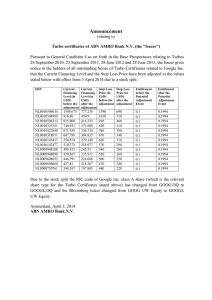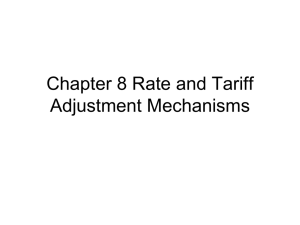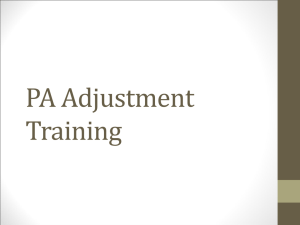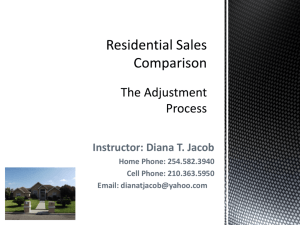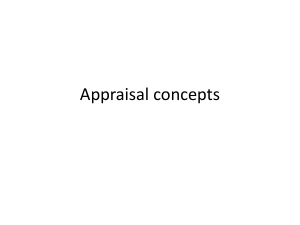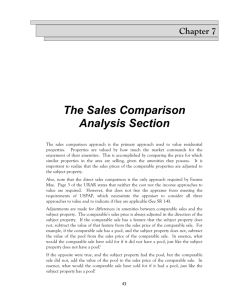march 1 sales comparison
advertisement
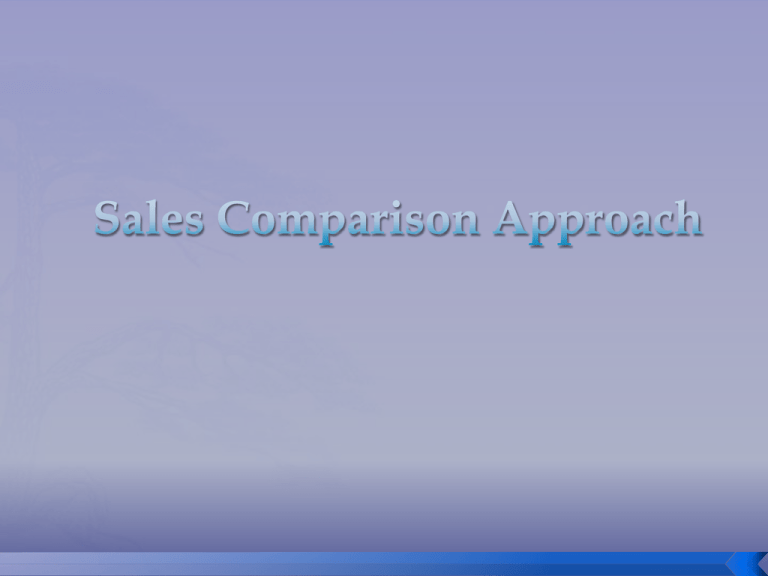
The most important part of an appraisal is the analysis of the market data available The market is telling you what people are willing to pay for land in a given circumstance Improved and unimproved sales What you are looking for is a sale with a single land class or something that you can use as the basis for making the comparisons • • Supply and demand; remember that the appraisal is made at a specific time and you have to know the effective demand and the supply of properties Substitution; REMEMBER the value of the property is set by the price paid to acquire a substitute property; changed by special circumstances and the appraiser has to be aware of these Externalities; neighborhood, services; roads, access to markets, … Balance; appraiser has to constantly stay in touch with what is happening not only in the neighborhood but throughout the industry • • • • • Obtain information on sales, listings and offers for all properties similar to the subject Verify that information; too many tall tales with respect to land; be aware! Get the right unit for comparison; dollars per acre; per square foot; other Compare the subject property and the comparable sales and adjust the price of comparables as needed or eliminate them Reconcile the values from the comparables into a single value or range of values • • Property rights conveyed; if there are leases and other encumbrances on the property and the desire is for a fee simple appraisal then adjustments may be necessary to make the subject and the sale the same; this adjustment should be done first Financing; the terms of the sales can have an impact on the price that is paid; appraisal should be adjusted to cash or cash equivalency basis for the appraisal Assume we have a 160 acre farm that sold for $600,000 with a $120,000 down payment and the seller financed the mortgage of $480,000 for 20 years at 5%. The market interest rate was 8%. The 20% down and the 20 years are within market parameters so only the low interest rate needs to be considered. $480,000 mortgage at 5% for 20 years has a payment of $38,516 per year. The present value of $38,516 for 20 years at 8% is $378, 156. $378,156 + $120,000 = $498,156 cash equivalent price $600,000 - $498,156 = $101,844 or $637 per acre adjustment Appraiser has to be careful in how they do this and what values they assume. If a financing adjustment is made it should be the second adjustment made • • • • • This can be a sale under duress or a sale as settlement of a divorce or something similar where there is a need for the sale. Sale to a relative; Purchase because of some special reason (sentimental) All these factors can influence the price paid It is best to not use such sales as a comparable but if you have to then be careful; this should be the third adjustment This is the basic idea that times changes and so do market conditions. Remember that the appraisal is made as of a specific date If conditions have not changed then there is no need for an adjustment, in other words don’t change the comparable simply to change it for time This should be the fourth change made This can be a major difference depending on the circumstances (3 most important things in determining the value of a piece of property) Roads, markets (ethanol plant, river, rail lines, etc. ) Urban centers ( farming opportunities, highest and best use) Land type ratios Ranges Land quality Timber Slope Percent tillable Percentage 1) Subject equal to comparison; no adjustment 2) When presented as “subject is…” then use multiplication 3) When presented as “the comparable is…” then use division • Subject is 10% superior to the comparable – • Subject is 10% inferior to the comparable – • Multiply the price of the comparable by .9 to estimate the value of the subject. % adjustment to the price of the comparable is minus 10% Comparable is 10% superior to the subject – • Multiply the price of the comparable by 1.1 to estimate the value of the subject. % adjustment to the price of the comparable is plus 10% Divide the comparable by 1.1 to estimate the value of the subject. % adjustment to comparable is minus 9% Comparable is 10% inferior to the subject – Divide the comparable by .9 to estimate the value of the subject. % adjustment to comparable is 11% Type of rights being conveyed Fee simple Financing conditions Conditions of the sale Market conditions Location Physical adjustments The key is to be consistent; don’t mix comparable to subject, and vice versa Dollar adjustments; Most common; dollars are added to or subtracted from comparable to obtain the value of the subject Provides market evidence for amount and direction of a particular adjustment Pair only two sales for the adjustment and check them against other sales Appraiser has to use some judgment “but judgment without market evidence is simply not acceptable appraisal practice.” Sale A Sale B $800 $750 160 160 • Selling price • Acres • Financing Cash Cash • Market conditions Current Current • Size 0 0 • Location ? ? • Land 0 0 • Buildings 0 0 • Adjusted price $800 $750 • • • • $50 per acre impact from the paved vs dirt road Appraiser will keep checking this amount as they find sales that let them make the comparison Once one adjustment has been ‘proved’ in the market it can be used for other comparisons Assume two similar sales except location and size • Sale C • • • • • • • • • Selling price Acres Financing Market Size Location Land Buildings Adjusted price Sale D $700 320 $750 160 Cash Current ? -$50 0 0 $650 Cash Current ? 0 0 0 $750 • • • • Adjustment is $100 per acre assuming that the adjustment of $50 for location holds Next is time adjustment Remember with time adjustment that the percentage adjustment is a reflection of compounding too Sale two years ago at $1000, next year at $1,100 and this year at $1,200 What’s the percent change due to time? • • • • • • • • • Selling Price Acres Financing Market conditions Size Location Land Buildings Adjusted Price • Sale E Sale F $780 320 $950 150 Cash Current $100 0 0 0 $880 Cash 1.5 yrs. 0 0 0 0 $950 What is the percentage change due to time? $880 - $950 = -$70 -$70/950 = -7.4%/1.5 = -4.9% Sale 1 yr. ago for $600,000 Sale this yr. for $742,000 but property had $65,500 in improvements Sale A: 160 Ac. on Hyw. 6, two miles from Growthville, all Class II soils, no improvements, sold 1 year ago for $1,200, Cash • Sale A Sale B Sale C Sale D $1,000 $860 $905 140 180 150 • Price $1,200 Acres 160 Financing Cash Market 1 yr. Location 2mi. Land 0 Improvements 0 • 5% decrease in land values over past year • • • • • • Subject 160 Cash Loan Cash Cash Now Now 1yr. Now 4 mi 6 mi. 7 mi. 6 mi. 0 0 0 0 0 0 0 0 First thing to do is to find a control sale. This is the sale as similar to the subject property as possible. Comparisons will be made to this sale Assume that we are interested in finding the market contribution of location using these sales. Time adjustments have to be made first Which is the most like the subject? • Sale C • • • • • • • • • • Selling Price $860 Acres 180 Financing Cash Market conditions Current Size 0 Location 6 miles Land 0 Buildings 0 Adjusted Price $ Difference due to location Sale A $1,200 160 Cash 0 2 miles 0 0 $ • Sale C • • • • • • • • • • Selling Price $860 Acres 180 Financing Cash Market conditions Current Size 0 Location 6 miles Land 0 Buildings 0 Adjusted Price $ Difference due to location Sale B $1,000 140 Cash Current 0 4 miles 0 0 $ • Sale C • • • • • • • • • • Selling Price $860 Acres 180 Financing Cash Market conditions Current Size 0 Location 6 miles Land 0 Buildings 0 Adjusted Price $ Difference due to location Sale D $905 150 Cash 0 7 miles 0 0 $ Appraisal of improved land starts with determining the value for each land class through evaluating sales of unimproved land These land classes will then be used to determine the value of the land to the sale and the residual will be the value of the improvements The value of the improvements will then be allocated among the buildings, etc. Assume that the appraiser knows that unimproved sales indicate this division for each land class Class I Class II Class III 100% 60% 40% What is the value of each land class if we had a sale for $260,000 with 100 acres of Class I, 200 acres of Class II and 100 acres of Class III. • • • • • • Class I 100%, Class II 60% and Class III 40% 100 ac. Class I, 200 ac. Class II, 100 ac. Class III $260,000 sale price 100 * 100% = 100 200 * 60% = 120 100 * 40% = 40 260 $260,000/260 = $1,000 Class I $1,000 * .60 = 600 Class II $1,000 * .40 = 400 Class III

